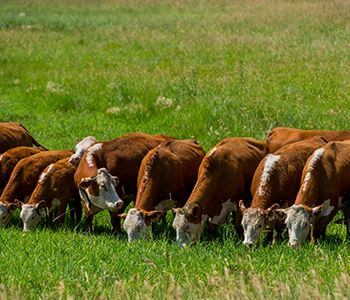PREVENTING GRASS TETANY IN YOUR HERD
Apr 13, 2020

With the snow melting away and the grass beginning to turn green again, cattle producers cannot wait to take cows and calves off muddy lots and graze them out on pasture again. However, early-season grass can be a recipe for grass tetany.
Young grass can be high in protein and potassium, which leads to poor absorption of magnesium. Grass tetany results from a magnesium deficiency in the bloodstream. In addition, cows in lactation have higher nutritional requirements, and being deficient in magnesium can cause problems in her milk production and overall health.
“Older cows and cows in peak lactation are at highest risk of suffering from grass tetany because they cannot mobilize magnesium from bone stores the way that younger animals can,” Dakotaland Feeds PhD Staff Nutritionist Roxanne Knock said.
Knock notes that magnesium deficiency can cause muscle contraction, resulting in muscle tremors, seizures, convulsions, recumbency (going down), and rapid death. Because of the rapid progression of the tetany, a cow cannot often be treated before death.
The bottom line is this: How can grass tetany be prevented before it becomes a problem?
Agtegra Feed Division Manager Scott Kilber recommends holding cattle off early-season grass in order to not only get cattle off to a better start but also prevent grass tetany issues in the future. However, when putting cows on pasture is a must, mineral needs to be supplemented.
“We typically provide extra magnesium through loose mineral, lick tubs or possibly cubes” Kilber said. The free choice options are generally the most effective because they are available all the time for the animals.”
Providing high magnesium mineral is the optimal prevention mechanism. However, as Knock points out, supplementing a few weeks before turning out on grass does not build up to protect the cow from grass tetany. Having a free choice source of magnesium available at the time of risk is provides the greatest protection. Providing hay or having old growth from the previous season decreases the risk of tetany by diluting the high protein and potassium found in the new grass too.
“Sometimes, waiting to turn out until the grass is at least 6 inches tall can mitigate the risk” Knock said. “Some pastures that are high in crested wheatgrass or other wheatgrass species are more tetany prone than others and so reserving some pastures for later grazing may be an option as well.”
Preventing grass tetany is important when turning your cows out on pasture. Monitor your pasture’s grass growth before turnout, supplement magnesium early and provide forage to offset the grass’ high protein and potassium before your cows become deficient in magnesium.
Protect your herd from grass tetany. Talk to your feed representative about magnesium supplement options for your herd today.
Young grass can be high in protein and potassium, which leads to poor absorption of magnesium. Grass tetany results from a magnesium deficiency in the bloodstream. In addition, cows in lactation have higher nutritional requirements, and being deficient in magnesium can cause problems in her milk production and overall health.
“Older cows and cows in peak lactation are at highest risk of suffering from grass tetany because they cannot mobilize magnesium from bone stores the way that younger animals can,” Dakotaland Feeds PhD Staff Nutritionist Roxanne Knock said.
Knock notes that magnesium deficiency can cause muscle contraction, resulting in muscle tremors, seizures, convulsions, recumbency (going down), and rapid death. Because of the rapid progression of the tetany, a cow cannot often be treated before death.
The bottom line is this: How can grass tetany be prevented before it becomes a problem?
Agtegra Feed Division Manager Scott Kilber recommends holding cattle off early-season grass in order to not only get cattle off to a better start but also prevent grass tetany issues in the future. However, when putting cows on pasture is a must, mineral needs to be supplemented.
“We typically provide extra magnesium through loose mineral, lick tubs or possibly cubes” Kilber said. The free choice options are generally the most effective because they are available all the time for the animals.”
Providing high magnesium mineral is the optimal prevention mechanism. However, as Knock points out, supplementing a few weeks before turning out on grass does not build up to protect the cow from grass tetany. Having a free choice source of magnesium available at the time of risk is provides the greatest protection. Providing hay or having old growth from the previous season decreases the risk of tetany by diluting the high protein and potassium found in the new grass too.
“Sometimes, waiting to turn out until the grass is at least 6 inches tall can mitigate the risk” Knock said. “Some pastures that are high in crested wheatgrass or other wheatgrass species are more tetany prone than others and so reserving some pastures for later grazing may be an option as well.”
Preventing grass tetany is important when turning your cows out on pasture. Monitor your pasture’s grass growth before turnout, supplement magnesium early and provide forage to offset the grass’ high protein and potassium before your cows become deficient in magnesium.
Protect your herd from grass tetany. Talk to your feed representative about magnesium supplement options for your herd today.